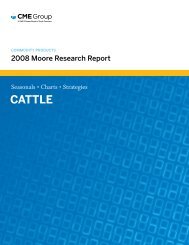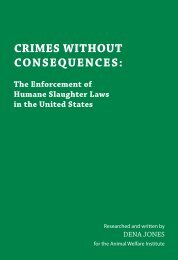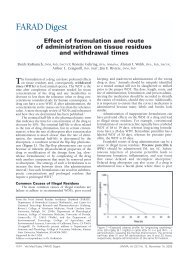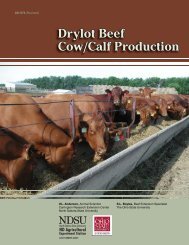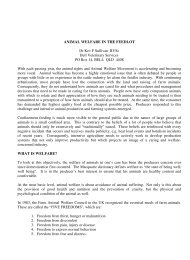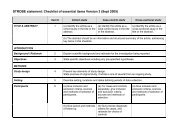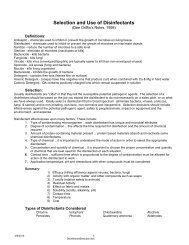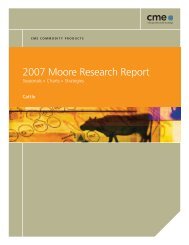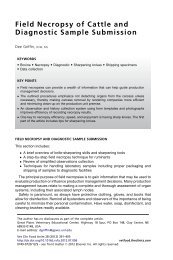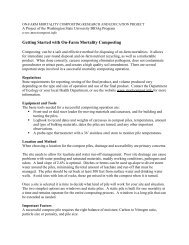Effect of management strategies on reducing heat stress of feedlot ...
Effect of management strategies on reducing heat stress of feedlot ...
Effect of management strategies on reducing heat stress of feedlot ...
You also want an ePaper? Increase the reach of your titles
YUMPU automatically turns print PDFs into web optimized ePapers that Google loves.
3082<br />
Mader and Davis<br />
Table 3. <str<strong>on</strong>g>Effect</str<strong>on</strong>g> <str<strong>on</strong>g>of</str<strong>on</strong>g> morning and evening wetting <str<strong>on</strong>g>of</str<strong>on</strong>g> <strong>feedlot</strong> pen surfaces <strong>on</strong> feed and water<br />
intake <str<strong>on</strong>g>of</str<strong>on</strong>g> yearling steers in Exp. 2<br />
Treatments a<br />
C<strong>on</strong>trast P-values b<br />
CON vs.<br />
Item CON AM PM SEM AM & PM AM vs. PM<br />
BW, kg<br />
Initial (d 0) 477 476 477 1.1 0.26 0.42<br />
Interim (d 34) 532 533 530 3.1 1.00 0.53<br />
Final (d 82) 632 639 628 4.9 0.75 0.16<br />
DMI, kg/d<br />
d 0 to 34 9.85 10.13 10.02 0.16 0.30 0.65<br />
d 35 to 82 11.23 11.52 11.54 0.20 0.26 0.97<br />
d 0 to 82 10.79 11.08 11.04 0.17 0.25 0.89<br />
G:F<br />
d 0 to 34 0.162 0.167 0.157 0.008 1.0 0.42<br />
d 35 to 82 0.188 0.190 0.178 0.004 0.47 0.07<br />
d 0 to 82 0.175 0.180 0.168 0.004 0.80 0.06<br />
Water intake, L/d<br />
d 0 to 34 37.63 38.29 35.29 0.21 0.08 0.01<br />
d 35 to 82 38.01 37.70 40.11 1.89 0.72 0.43<br />
d 0 to 82 38.32 38.42 38.59 1.12 0.90 0.92<br />
Water intake, L/Mcal <str<strong>on</strong>g>of</str<strong>on</strong>g> ME intake<br />
d 0 to 34 1.22 1.21 1.13 0.02 0.16 0.10<br />
d 35 to 82 1.09 1.05 1.11 0.07 0.94 0.54<br />
d 0 to 82 1.14 1.11 1.12 0.05 0.71 0.89<br />
a CON = no water applicati<strong>on</strong>; AM = water applied to pen surface between 1000 and 1200; PM = water<br />
applied to pen surface between 1400 and 1600.<br />
b Single-df orthog<strong>on</strong>al c<strong>on</strong>trasts.<br />
5); however, from d 22 to 83 (0.1715 vs. 0.1800) and d<br />
57 to 83 (0.1480 vs. 0.1695), sprinkling numerically (P =<br />
0.09) enhanced efficiency <str<strong>on</strong>g>of</str<strong>on</strong>g> feed c<strong>on</strong>versi<strong>on</strong>. Also, there<br />
was a feeding time × sprinkling interacti<strong>on</strong> for water<br />
intake from d 22 to 56, with AMF/DRY steers having<br />
greater (P < 0.05) water intake than the other treatments.<br />
Also, PMF/WET steers c<strong>on</strong>sumed 5% less (P<br />
< 0.05) water than AMF/WET steers, with PMF/DRY<br />
steers being intermediate. Water intakes during the<br />
final phase <str<strong>on</strong>g>of</str<strong>on</strong>g> the trial (d 57 to 83) c<strong>on</strong>tinued to display<br />
a feeding time × sprinkling interacti<strong>on</strong> (P < 0.05), with<br />
AMF/DRY steers averaging approximately 13% greater<br />
water intake than the other treatments. During the<br />
entire experimental period, AMF/DRY steers had<br />
greater (P < 0.05) water intake than all other treatments.<br />
When water intake was adjusted for ME intake,<br />
differences between treatments were <strong>on</strong>ly detected during<br />
d 57 to 83. Water intake per unit <str<strong>on</strong>g>of</str<strong>on</strong>g> ME intake was<br />
11% greater (P < 0.05) for AMF/DRY steers than all<br />
others. Because drinking water will provide cooling to<br />
the animal, greater water intakes would be expected<br />
for the AMF/DRY group.<br />
Bunk scores <str<strong>on</strong>g>of</str<strong>on</strong>g> steers in Exp. 3 for TNL, MHS, and<br />
SHS envir<strong>on</strong>mental c<strong>on</strong>diti<strong>on</strong>s are shown in Table 6.<br />
For equal comparis<strong>on</strong>, bunk scores were compared for<br />
the effect <str<strong>on</strong>g>of</str<strong>on</strong>g> sprinkling <strong>on</strong> the different feeding <str<strong>on</strong>g>strategies</str<strong>on</strong>g><br />
independently. Bunk scores <str<strong>on</strong>g>of</str<strong>on</strong>g> AMF and PMF<br />
steers were designed to differ at least for part <str<strong>on</strong>g>of</str<strong>on</strong>g> the day.<br />
Under TNL, sprinklers did not operate. There was<br />
no difference in bunk scores <str<strong>on</strong>g>of</str<strong>on</strong>g> AMF steers with respect<br />
to sprinkling at any observati<strong>on</strong> (P > 0.20); however,<br />
steers fed in the afterno<strong>on</strong> without access to sprinklers<br />
(PMF/DRY) had a larger percentage (P < 0.001) <str<strong>on</strong>g>of</str<strong>on</strong>g> bunks<br />
receiving a score <str<strong>on</strong>g>of</str<strong>on</strong>g> 0 and 1 at 1700 than did PMF/WET<br />
steers, although no differences in bunk scores were observed<br />
at 2000.<br />
Bunk scores during MHS differed at 1400 for steers<br />
fed in the morning and at 2000 for steers fed in the<br />
afterno<strong>on</strong>, with sprinkled AMF cattle having fewer<br />
scores <str<strong>on</strong>g>of</str<strong>on</strong>g> 2 at 1400, and no scores <str<strong>on</strong>g>of</str<strong>on</strong>g> 1 or 2 at 2000<br />
for PMF-treated cattle, indicating that sprinkling was<br />
effective in stimulating DMI under those c<strong>on</strong>diti<strong>on</strong>s.<br />
For all treatment groups, the majority, if not all, <str<strong>on</strong>g>of</str<strong>on</strong>g> the<br />
feed was c<strong>on</strong>sumed by 2000. Under SHS, sprinkling<br />
steers did not alter bunk scores. When compared with<br />
TNL and MHS c<strong>on</strong>diti<strong>on</strong>s, a greater quantity <str<strong>on</strong>g>of</str<strong>on</strong>g> feed<br />
remained at 2000 for all treatments. The AMF/WET<br />
and PMF/WET cattle had numerically (8.33%) more<br />
bunk scores at 0, but under these c<strong>on</strong>diti<strong>on</strong>s, all cattle<br />
were apparently too uncomfortable to eat.<br />
Carcass Traits. Carcass characteristics are presented<br />
in Table 7. In Exp. 1, feeding regimen had no effect <strong>on</strong><br />
carcass weight, dressing percent, or 12th-rib fat. Steers<br />
<strong>on</strong> the BKMGT treatment had numerically (P = 0.17)<br />
greater marbling scores than the other treatment<br />
groups. In Exp. 2, marbling scores <str<strong>on</strong>g>of</str<strong>on</strong>g> PM steers tended<br />
(P = 0.06) to be higher than AM. All other carcass characteristics<br />
were similar. In Exp. 3, steers did not differ<br />
(P > 0.10) in hot carcass weight or dressing percent<br />
(348.0 ± 2.0 kg and 61.7 ± 0.4%, respectively). Fat thickness<br />
likewise was not affected by treatment (P > 0.10).<br />
A feeding time × sprinkling interacti<strong>on</strong> (P < 0.05) was




